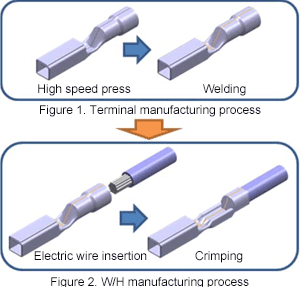Furukawa Automotive Systems Develops Aluminum Harness Connection Technology for Use with Next-generation Vehicles
- Leading the world in helping to make vehicles lighter using a corrosion-proof structure -
Furukawa Automotive Systems Inc. (main office: Shiga; representative: Katsumi Shibata; "Furukawa Automotive Systems" below), a member company of the Furukawa Electric Group, has succeeded in developing corrosion-proof terminals ("α Terminal Series") for application to aluminum wires in wire harnesses ("W/H") for use in vehicles. Furukawa Automotive Systems began mass production in August of this year. Boasting both superior corrosion-proof properties and reduced costs over conventional corrosion-proof treatments, this development is expected to further accelerate the usage of aluminum W/H.
Background
Aluminum W/H have recently been gaining attention due to the development of increasingly lighter vehicles, depleting copper resources, and increasing prices. Preliminary calculations have shown that using aluminum components can decrease the total weight of the W/H of a large SUV three to four times over, which could also contribute to improving the fuel efficiency of said vehicles.
However, using aluminum W/H results in good electrical connections between aluminum wires and (copper alloy) terminals, so anti-corrosion measures must be applied to terminals between these dissimilar metals. Until now there were various obstacles in the way of the wider utilization of aluminum W/H, such as increased manufacturing costs due to additional processing required during terminal crimping when manufacturing aluminum W/H, and a lack of general versatility due to such W/H requiring dedicated connector housings(Note 1).
Content
Furukawa Automotive Systems has successfully developed the "α Terminal Series" corrosion-proof terminals, which offer high airtightness and boast a world-class corrosion-proof structure. Mass production began this year. The terminals were selected for use in the new Toyota LandCruiser 200 series, which was launched in August of this year.
The terminal crimping area of the newly developed "α Terminal Series" is formed using a standard high speed press. The crimping area is then shaped into a sealed tube using Furukawa Electric's own optical fiber laser welding technology (Fig. 1). During the W/H manufacturing process, the electric wire end covering is swaged as the aluminum wire is crimped (Fig. 2), to give the resulting terminal a superior corrosion-proof structure that is highly airtight.
This method eliminates the need for additional corrosion-proofing such as resin molding or painting, as corrosion-proofing is complete once conventional electric wire crimping technology is applied. The shape of the resulting terminal also allows existing connector housings to be used without modification. All in all, compared with conventional resin molding and painting methods this new method results in corrosion-proofing that has a wider range of application and is well-suited to mass production.
Furukawa Automotive Systems will continue to propose the "α Terminal Series" to all automobile manufacturers, in an attempt to help accelerate the adoption of aluminum W/H and contribute to making green-energy cars.

(note 1)Connector housing:
A part that houses the crimped electric wire terminal, provides insulation between diodes, and joins/maintains male and female terminals. These versatile parts are widely used and feature many variations to meet the needs of W/H of all types, such as pole numbers and terminal arrangements for each type of terminal.
About Furukawa Automotive Systems Inc.
| Established | November, 1950 |
|---|---|
| Capital | 3,000,000,000 yen |
| President | Katsumi Shibata |
| Head office | 1000 Amago, Koura-cho, Inukami-gun, Shiga |
| Business operations | Design, development, manufacture and sale of wire harnesses (cable assembly for automobiles), related electronic products and other in-car functional products |
| Ratio of stock held by Furukawa Electric: | 100% (as of March 2015) |
About Furukawa Electric Group
Furukawa Electric (TSE; 5801, ISIN; JP3827200001) Group started business in 1884, when its copper-smelting facility and wire manufacturing factory was established. Since then Furukawa Electric has become pioneers in the latest technologies by addressing diverse technological issues. Furukawa Electric has released products in a number of areas, including telecommunications, electronics, automobiles, and construction, with the three types of materials it works with at their core, namely, optics, plastics, and metals. Many of these products have attained the top global market share, and all of its products have contributed to society in numerous business areas. Furukawa Electric reported consolidated revenues of JPY 867.8 billion (approximately USD 8.2B) for the fiscal year ended March 31, 2015.







 Share
Share Tweet
Tweet Share
Share